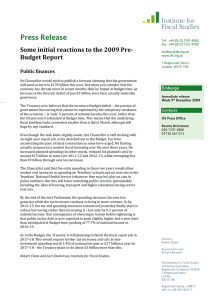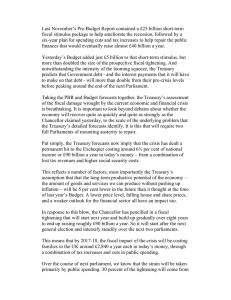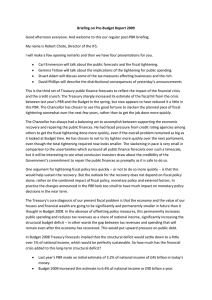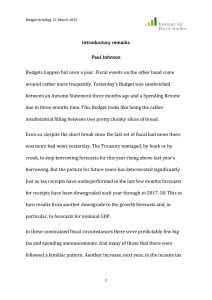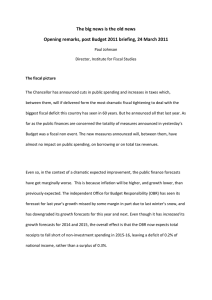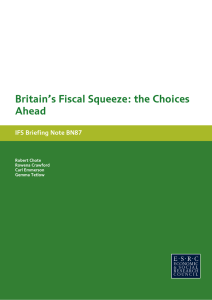Yesterday the Chancellor was able to report what passes for... current bleak fiscal climate, namely that the Government looks likely...
advertisement
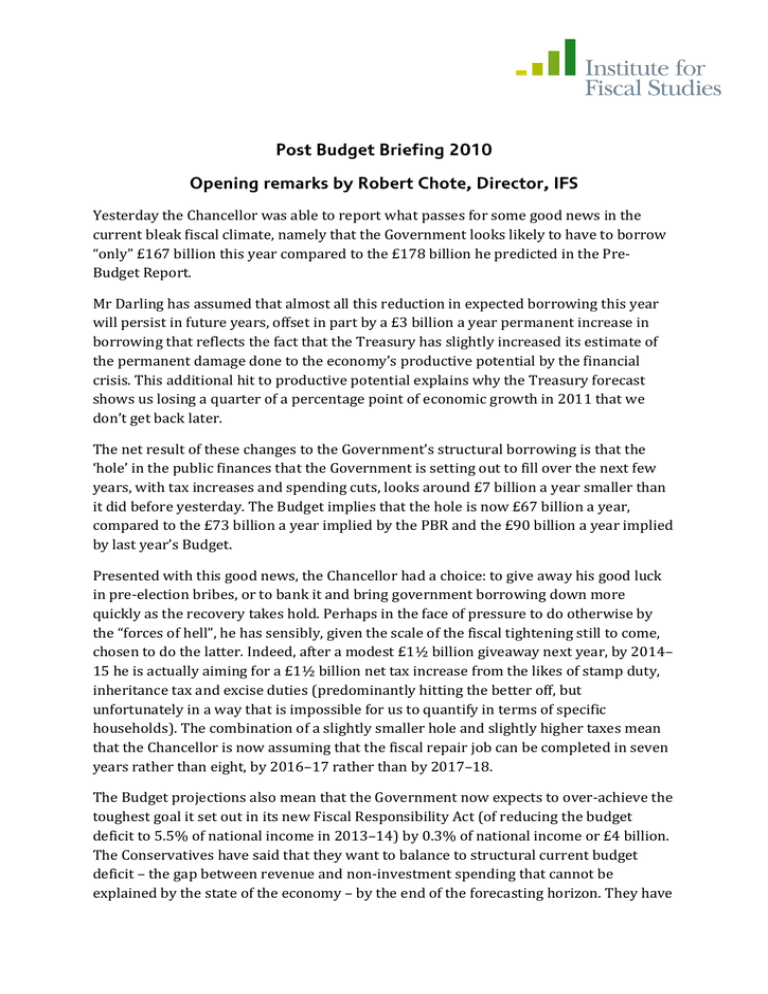
Yesterday the Chancellor was able to report what passes for some good news in the current bleak fiscal climate, namely that the Government looks likely to have to borrow “only” £167 billion this year compared to the £178 billion he predicted in the PreBudget Report. Mr Darling has assumed that almost all this reduction in expected borrowing this year will persist in future years, offset in part by a £3 billion a year permanent increase in borrowing that reflects the fact that the Treasury has slightly increased its estimate of the permanent damage done to the economy’s productive potential by the financial crisis. This additional hit to productive potential explains why the Treasury forecast shows us losing a quarter of a percentage point of economic growth in 2011 that we don’t get back later. The net result of these changes to the Government’s structural borrowing is that the ‘hole’ in the public finances that the Government is setting out to fill over the next few years, with tax increases and spending cuts, looks around £7 billion a year smaller than it did before yesterday. The Budget implies that the hole is now £67 billion a year, compared to the £73 billion a year implied by the PBR and the £90 billion a year implied by last year’s Budget. Presented with this good news, the Chancellor had a choice: to give away his good luck in pre-election bribes, or to bank it and bring government borrowing down more quickly as the recovery takes hold. Perhaps in the face of pressure to do otherwise by the “forces of hell”, he has sensibly, given the scale of the fiscal tightening still to come, chosen to do the latter. Indeed, after a modest £1½ billion giveaway next year, by 2014– 15 he is actually aiming for a £1½ billion net tax increase from the likes of stamp duty, inheritance tax and excise duties (predominantly hitting the better off, but unfortunately in a way that is impossible for us to quantify in terms of specific households). The combination of a slightly smaller hole and slightly higher taxes mean that the Chancellor is now assuming that the fiscal repair job can be completed in seven years rather than eight, by 2016–17 rather than by 2017–18. The Budget projections also mean that the Government now expects to over-achieve the toughest goal it set out in its new Fiscal Responsibility Act (of reducing the budget deficit to 5.5% of national income in 2013–14) by 0.3% of national income or £4 billion. The Conservatives have said that they want to balance to structural current budget deficit – the gap between revenue and non-investment spending that cannot be explained by the state of the economy – by the end of the forecasting horizon. They have not said what that horizon would be, but if we make the plausible assumption that it would remain five years as now than the extra fiscal tightening that they would need to achieve by 2015–16 on top of that planned by Labour has fallen from 1.1% of national income (£15 billion) before the Budget to 0.6% of national income (£8 billion) after it. But bear in mind that this is simply bringing forward some of the pain Labour would expect to inflict later. So how plausible are these projections? It would certainly be churlish for us to quibble with the forecast that borrowing will come in at £167 billion this year – that is exactly the number we predicted in our Green Budget early last month. But we also said in the Green Budget that we expected tax revenues to grow slightly more slowly than the Treasury over the next few years even if the economy performs as they project. And the Treasury’s forecasts for economic growth over the next few years remain higher than the average of independent forecasts. Both suggest that that modest additional room for manoeuvre implied by yesterday’s forecasts may be even more modest than it looks, if there is any at all. On the other hand, if unemployment falls as the Treasury expects – rather than as it constrains itself to assume when forecasting the public finances – that would put some extra room for manoeuvre back. Remember, of course, that the uncertainties surrounding all such forecasts for the public finances are very large and any sensible Government or would-be government will be thinking about Plan B and Plan C if the economy or the public finances end up behaving differently. If the Conservatives win the general election, bear in mind also that all these forecasts and assumptions will be scrutinised by Sir Alan Budd and his colleagues in the interim Office for Budget Responsibility before their first Budget. Potentially that could end up painting a very different picture of the fiscal challenge in prospect. In a Pre-Election Budget, perhaps the most that we can expect of any Chancellor is that he should observe the key tenet of the Hippocratic Oath and “above all, do no harm”. Judged against that modest yardstick, the broadly neutral stance of this Budget passes the test. Indeed it was a more parsimonious pre-election Budget certainly than those going back to 1987. But, as we will hear, some of the tax measures announced in yesterday’s Budget do not necessarily pass the “do no harm” test. Judged against the more testing yardstick of providing a detailed picture to voters and financial market participants of the fiscal repair job in prospect beyond the election, the Budget will have fallen short of many people’s hopes. There are an awful lot of judgements still to be made ,or revealed, notably with regards public spending over the next parliament. This greater-than-necessary vagueness allows the opposition to be vaguer than necessary too. What we do know from the Budget is that the Government expects public spending in total to be broadly flat in real terms over the four years beyond 2010–11. Making plausible assumptions for the growth of debt interest, social security and other Annually Managed Expenditure, our best guess is that (in the absence of further measures to reduce welfare spending) Whitehall spending on public services and administration would need to fall by an average of 3.1% a year over those four years, a cumulative decline of 11.9% or £46 billion a year in real terms by 2014–15. This implies cuts averaging between 5.3% a year and 7.1% in the areas that the Government is not planning to “protect” in 2011–12 and 2012–13, depending on whether it was to extend that protection for the remaining two years or not. Capital investment spending is set to bear the brunt of the decline, with a real cut averaging 14.9% a year over the four years. Indeed, it is interesting that in both this Budget and last year’s Pre-Budget Report, the Chancellor has in effect announced that the total fiscal tightening necessary is smaller than he previously thought and that more of the remaining hole will be filled with tax increases. But on both occasions he has used this to loosen the expected squeeze on current spending rather than capital spending. So cuts in capital investment are being relied upon for an increasingly large share of the tightening. Of the £46bn a year of real cuts in public services spending that we think the Budget forecasts would require by 2014–15, the Government would presumably claim to have “found” about £20 billion by 2012–13 from pay restraint, cutting programmes and efficiency savings. We should be wary of some of these claims, particularly on efficiency: First, because it is not obvious that the efficiency savings would be delivered. The NAO still disputes the Government’s claimed savings from the Gershon Review in the 2004 spending review. And, of the £35 billion of savings it is seeking in the three years from April 2008 to April 2011, even the Government claims in the Budget to have found only £10.8 billion – less than a third – over the first half of this period. Second, and more fundamentally, if they are cutting out genuine waste we would expect the Government to try to achieve most of these efficiencies even if it was not having to cut public spending overall. Efficiency savings that can and should be delivered in any event do not narrow the gap between the quality and quantity of public services that we would enjoy with spending cuts and without them. They are not free money and they do not mean that spending cuts are painless. To conclude, this was – as we might have expected – a “treading water” budget. Many questions about the size and structure of the fiscal tightening remain to be answered and are unlikely to be answered this side of the general election.

